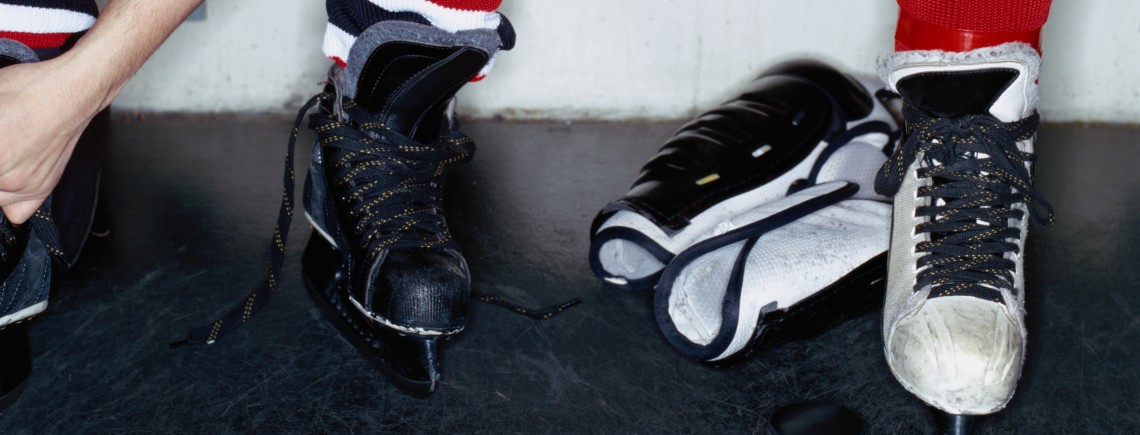Break the Ice: Get Hooked on Hockey and Own Your Game
To me, nothing says winter in Canada quite like playing ice hockey.
The butterflies bubbling in my stomach before the puck drops, the synergy of my blades gliding across the ice, the breeze of cold air swishing over my face. My mind goes empty, everything melts away, and I’m reminded once again that I am, indeed, alive.
As much as I’m smitten with hockey now, it hasn’t always been a lifelong romance.
Playing hockey growing up was an activity expected of me as a Canadian boy. While I enjoyed the athletics of hockey, everything else associated with it didn’t feel right. I felt a bit like a rainbow-coloured sheep dropped into the middle of hockey’s predatory, hyper-masculine culture, where fighting is a rite of passage, preventable injuries are trophies, and homophobia is a bonding ritual.
Having quit playing as a teenager, I said goodbye to hockey and we parted ways.
It wasn’t until later on, as an adult, that I ventured to try it again – this time in a league of my peers. The Toronto Gay Hockey Association is the largest LGBTQ-centric hockey league in the world, 11 teams strong.
Through the TGHA I have met people from all over the world; made lifelong friends, found workout buddies, and networked professional contacts; I’ve been part of community of like-minded people; and best of all I get to play a fantastic sport!
I’ll be the first to admit, though, that hockey requires a lot of work! The trickiest parts of getting into hockey are those first few strides: finding the right league, the necessary equipment, and developing the skills needed cause a lot of us to “take a pass” on the hockey arena.
Here’s your complete 101 to getting the puck sliding on your hockey game.
Planning Ahead:
While hockey is currently in mid-season, right about now is the best time to start planning ahead for next season.
- Research a mix of leagues to find the one for you. Here’s a few to get you started: Adult Safe Hockey League, CARHA, or Hockey Canada’s Adult Recreational.
- Go cheer on a game or two as a spectator to get a feel for what it’s like.
- Start assembling your equipment. You don’t have to buy everything new – EVERY hockey player uses a combination of used equipment collected from friends, family, and teammates, alongside new, store-bought stuff.
- Hit an outdoor ice rink now and break in your skates ahead of schedule. Since skates don’t offer much in the way of impact protection from pucks, these are a must in my books: Skate Fenders.
Getting Your Mind and Body Ready:
Cardiovascular
A conditioned cardiovascular system is key, given that a game of hockey is similar to a session of high-intensity interval training. For one minute you’re giving everything you have, pushing yourself further than you thought possible; and in the next you’re idle on the bench, gulping down air like your life depends on it – and then before you know it, your teammate is coming off and it’s go-time again.
Flexibility
Skating is the crux of hockey and increased flexibility, especially in the hips, will help to make your skate strides stronger, longer, and more limber. As demonstrated by Kathleen Trotter, side lunges and walking squats are two ideal movements to master for skaters.
Strength and Balance
Playing hockey requires you to twist and turn in different directions, all while holding your body in a semi-squat position. Developing core strength with weight-training is essential for preventing injury – especially to the back. Three of my favourites are the front squat, Romanian dead lift, and dumbbell lunge.
Mental Sharpness
Get your skating skills down pat as a first step. Ideally, you want to be able to skate without having to concentrate too much on the movement, leaving more mental room for you to focus on everything else coming at you. The only way to do this is to practice, practice, and practice again. Carve those muscle memories into your brain with these skating drills from How To Hockey.
Breaking the ice and starting hockey as a sport can be intimidating, but once you get out there and feel the ice under your blades and the buzz of energy in the air, you might just find yourself getting happily hooked, like I did.
Ready to break the ice?
What have social sports brought to your AHAA lifestyle? Share your experiences here or on our Facebook and Twitter pages.



